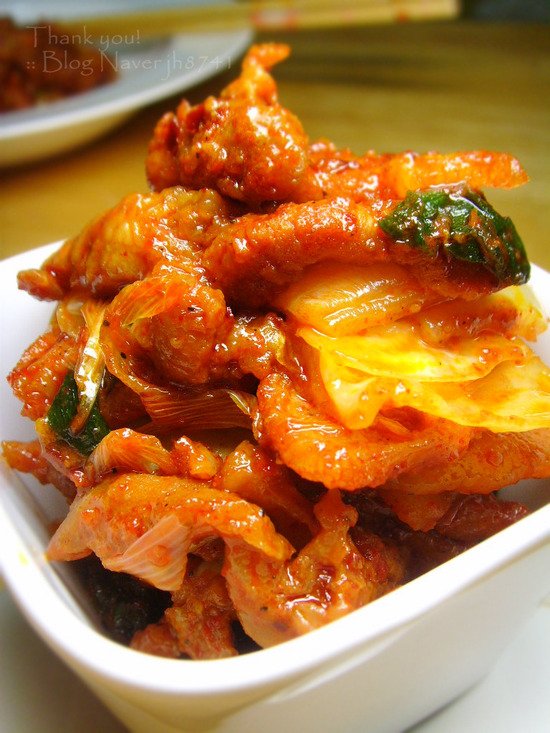Spicy Stir-Fried Pork (Jeyuk Bokkeum)
How to Make Delicious Jeyuk Bokkeum Using Leftover Pork Belly

Have leftover pork belly you need to use up quickly? This recipe transforms it into a wonderfully delicious Jeyuk Bokkeum! It’s incredibly tasty and a perfect way to use up those odds and ends in your fridge. Enjoy a flavorful meal with minimal effort.
Main Ingredients- Pork belly 236g
- 1/3 medium onion
- 1/3 stalk green onion
- 40g cabbage
- 5 perilla leaves (깻잎)
Seasoning- 1 Tbsp gochujang (Korean chili paste)
- 1/2 Tbsp soy sauce
- 1/3 Tbsp minced garlic
- 1/3 Tbsp sesame oil
- 1 Tbsp gochugaru (Korean chili flakes)
- 1 Tbsp soju (or cooking wine)
- 1 Tbsp gochujang (Korean chili paste)
- 1/2 Tbsp soy sauce
- 1/3 Tbsp minced garlic
- 1/3 Tbsp sesame oil
- 1 Tbsp gochugaru (Korean chili flakes)
- 1 Tbsp soju (or cooking wine)
Cooking Instructions
Step 1
If you’re using pork belly, it’s a good idea to lightly season it beforehand with salt and pepper to remove any gamey odor and enhance its flavor. Pork belly, in particular, benefits from a little seasoning to cut through its richness. If using frozen pork belly, remove any bones as they can make the texture tougher and less pleasant compared to fresh pork belly, where the slight crunch can be enjoyable. Pepper helps with odor removal and adds a subtle spice, but use it sparingly to avoid making the dish too salty. Just a tiny pinch of salt and pepper is needed; use even less pepper than shown in the picture.

Step 2
While the pork is marinating, prepare your vegetables. Slice the onion and cabbage into bite-sized squares. The green onion can be roughly chopped or cut into large pieces. Tear the perilla leaves into larger pieces as well. If you don’t have many vegetables on hand, don’t worry! You can substitute with extra onion and green onion, as these alone make the dish incredibly delicious. I’m using up various leftover ingredients that I had in my fridge.

Step 3
Now, combine the marinated pork with all the seasoning ingredients in a bowl. Get your hands in there and mix everything vigorously, ensuring the sauce coats the meat evenly. A helpful tip here is that the soy sauce is mainly for the initial seasoning; most of the flavor comes from the gochujang. If you’re using store-bought gochujang, keep in mind it can be quite salty and sweet, so adjust accordingly. Gochujang is key to Jeyuk Bokkeum. For a more intense, spicy kick, use more gochujang. If you prefer a milder, more ‘adult’ flavor, you can slightly increase the soy sauce and reduce the gochujang.

Step 4
Heat a pan over medium-high heat and add the marinated pork. Cook it until it’s about 80-90% done. Avoid overcooking the pork, as it can become tough. Afterwards, add all the prepared vegetables (onion, cabbage, green onion) to the pan, reserving the perilla leaves for later. Stir-fry them just until they are tender-crisp, or to your desired level of doneness. If you prefer softer vegetables, cook them a bit longer, but be mindful of the pork. Cooking the vegetables for a shorter time will help maintain their pleasant bite. For an extra spicy kick, consider adding some chopped chili peppers like Cheongyang peppers.

Step 5
Once the vegetables are cooked to your liking and well combined with the pork, turn off the heat. Add the perilla leaves and give it a few quick stirs to combine. This is the final step! If you plan to serve the Jeyuk Bokkeum as a wrap, you can omit the perilla leaves. If you intend to eat it immediately, this is perfect. However, if you plan to store it and eat it the next day, you might want to add a little more gochujang. As the dish sits, the flavors meld, and it might taste less potent than when freshly made.




